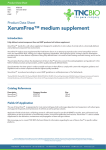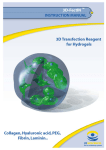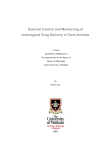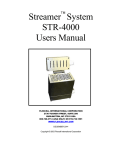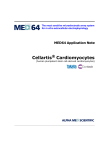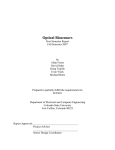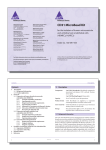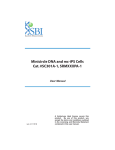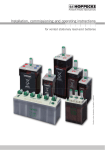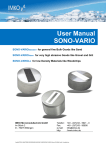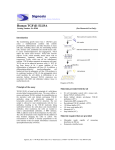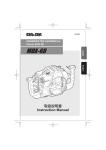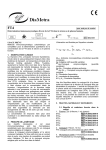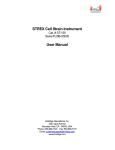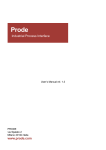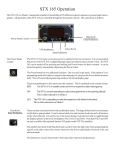Download Instructions for use
Transcript
Instructions For Use Doc: Date: Rev: XF205instructions 11-jan-2012 1 Instructions For Use – XerumFree™ XF205 Medium Supplement Adapting Cells To a Serum-Free Environment Fully defined, animal-component free and GMP produced cell culture supplement. Performing cell culture without serum can be challenging. However, the rewards do largely recompense the efforts, and re-discovering the basics of cell culture develops quickly into a passion. The intention of this paper is to guide the user to a smooth transition to serum-free conditions and to avoid all inadequate or inappropriate efforts. Ideally, the transition to serum-free conditions should be carried out over several passages to gradually select cells that can grow under serum-free conditions. However, direct adaptation to serum-free environments may also work out successfully, provided that all crucial aspects are addressed properly. Regardless of the method used, key concerns include the growth state of the cellular inoculum, cell seeding density, sub-cultivation techniques, and biophysical attributes of the cell culture system. TNCbio’s XerumFree™ serum replacement has been designed so as to be used in the same way as conventional cell culture sera, as a medium supplement. The concentration however is 5x higher, so typically you will use 2% to a basal medium. You will go through the same steps as usual. CONTENTS Important notes before use 1 1.1 1.2 1.2.1 1.2.2 Prepare General preperation of the cell culture medium General adaption methods to serum-free conditions Direct adaptation Sequential adaptation 2 2.1 2.1.1 2.1.2 Use XF205 Cell Lines Anchorage-dependent Cell Lines Anchorage-independent Cell Lines 2.2 2.2.1 2.2.2 2.2.3 Stem Cells Preliminary step – Coating Culture of hESCs and hiPSCs Culture of MSCs 2.3 2.3.1 2.3.2 2.3.3 Primary Cultures Common recommendations Cell specific recommendations Recommendend set up IMPORTANT NOTES BEFORE USING Concentrated XerumFree™ XF205: - XF205 is a cell culture medium additive replacing serum, so it is not a final medium. - XF205 must be added to a basal cell culture medium (e.g. IMDM, DMEM-F12 or any other basal medium of choice). - Do not to filter XerumFree™ XF205 or the medium after adding XerumFree™ - If needed filter your medium first and then add XerumFree™ XF205 under sterile conditions. - XF205 is 5x concentrated compared to serum, so use an equal lower amount (e.g. 2% XF205 replaces 10% FBS) - XF205 does not contain growth factors like cytokines, hormones etc. Therefore also no insulin*. The information provided on this Instruction for Use was acquired by diligent search and/or investigation and the recommendations are based on cautious application of professional judgment. The information given is designed only as a guide for handling, use, and processing and is not to be considered as a warranty or quality specification. All materials and mixtures may present unknown hazards and should be used with caution. The information relates only to the specific material designated and may not be valid for such material used in combination with any other material or in any process, unless specified in the text. THE INFORMATION IN THESE INSTRUCTIONS FOR USE DO NOT CONSTITUTE A WARRANTY, EXPRESS OR IMPLIED, INCLUDING ANY IMPLIED WARRANTY OF MERCHANTABILITY OR FITNESS FOR ANY PARTICULAR PURPOSE. TNC BIO BV | Smalle Haven 95 | 5611 EH Eindhoven | The Netherlands | T +31 4030 400 80 | [email protected] | www.tncbio.com 1/ Instructions For Use Doc: Date: Rev: XF205instructions 11-jan-2012 1 Instructions For Use – XerumFree™ XF205 Medium Supplement 1 Preparing 1.1 General preparation of the serum-free cell culture medium Gently shake the bottle of XerumFree™ shortly before use. Add XerumFree™ to your preferred basal medium at a 5x lower concentration compared to serum (e.g. 10% FBS equals 2% XF205). Do not filter XerumFree™ or the medium after adding XerumFree™ (XF205 is sterile). If needed filter the medium before adding XF. Do not add any antibiotics at this stage. In fact, antibiotics like many compounds bind to the plasma proteins of serum, in particular to the albumin fraction. Thus, the same concentration of antibiotics will exhibit a much higher biological activity in serum- and albumin-free conditions and this increased activity may have deleterious impacts on cell growth. In case ‘antibiotic-free culture’ is deemed unworkable, the use of gentamycin is suggested at the concentration of 50 mg/l. *Some users prefer or need to grow their cells free of insulin. In case of XerumFree™ the decision to grow cells with or without insulin (and/or other growth factors) is yours. If insulin is needed for cell growth and performance we advise to add recombinant insulin in a concentration of 1.25 mg/l final cell culture medium. 1.2 General adaption methods to serum-free conditions There are basically two approaches to adapt cells to growth in serum-free environment: 1.2.1 Direct Adaptation Which is carried out by a direct transfer of the cells from the serum-containing medium into the serum-free medium. 1.2.2 Sequential Adaptation or Weaning Method, Pass the cells from the original serum containing medium sequentially through the following phases where each step halves the serum-supplemented media, thus increasing the serum-free media to aproximately below values: Phase 1: 50 % XerumFree-supplemented medium / 50 % Serum-supplemented medium Phase 2: 75 % XerumFree-supplemented medium / 25 % Serum-supplemented medium Phase 3: 87.5 % XerumFree-supplemented medium / 12.5 % Serum-supplemented medium Phase 4: 93.75 % XerumFree-supplemented medium / 6.25 % Serum-supplemented medium Phase 5: 96.88 % XerumFree-supplemented medium / 3.12 % Serum-supplemented medium Phase 6: 98.44 % XerumFree-supplemented medium / 1.56 % Serum-supplemented medium Phase 7: 100 % XerumFree-supplemented medium In case of reduced growth go back one step and continue after growth is established again. Cell cultures may consist of cell lines (adherent or suspension growth) or primary cultures. Moreover, from a functional point of view, cell types may be differentiated to various degrees or exhibit undifferentiated characteristics, as in the case of stem cell preparations.In each case, the adaptation protocol has to take into account the specific requirements of the cell type in order to guarantee the best chances for success. For this reason we have separated our specific adaptation procedures into three parts, corresponding to 2.1 – Cell Lines 2.2 – Stem Cells 2.3 – Primary Cultures The information provided on this Instruction for Use was acquired by diligent search and/or investigation and the recommendations are based on cautious application of professional judgment. The information given is designed only as a guide for handling, use, and processing and is not to be considered as a warranty or quality specification. All materials and mixtures may present unknown hazards and should be used with caution. The information relates only to the specific material designated and may not be valid for such material used in combination with any other material or in any process, unless specified in the text. THE INFORMATION IN THESE INSTRUCTIONS FOR USE DO NOT CONSTITUTE A WARRANTY, EXPRESS OR IMPLIED, INCLUDING ANY IMPLIED WARRANTY OF MERCHANTABILITY OR FITNESS FOR ANY PARTICULAR PURPOSE. TNC BIO BV | Smalle Haven 95 | 5611 EH Eindhoven | The Netherlands | T +31 4030 400 80 | [email protected] | www.tncbio.com 2/ Instructions For Use Doc: Date: Rev: XF205instructions 11-jan-2012 1 Instructions For Use – XerumFree™ XF205 Medium Supplement 2.1 Cell Lines 2.1 Cell lines The following protocols are valid for normal (diploid, limited lifespan) or transformed or immortalized cell lines (with indefinite lifecycle). 2.1.1 Anchorage-dependent Cell Lines Critical success factors: - coating of the cell culture support for optimal cell attachment - minimize action of trypsin - choice of the antibiotic system Experimental Steps A) Coat the cell culture surface with an adequate cell-attachment factor by using - a commercial coating kit such as Pronectin™ F , MapTRIX™ or equivalent, or - a Fibronectin or Poly-L-Lysine coating, or - a little FBS (e.g, 500 µl for a T25 flask) with overnight incubation at 37°C, followed by two washes with PBS or fresh medium - ready to use plastics that provide an improved attachment of adherent cells B) Dissociate the cell monolayer - the use of standard trypsin preparations can become somewhat problematic in the absence of serum, which contains trypsin inhibitors. It is therefore important to minimize the proteolytic activity of residual trypsin in serum-free conditions in order to avoid irreversible damage to the cells. This can be best achieved by the use of trypsin inhibitors (e.g. from soybean) or by employing a non-mammalian dissociation reagent such as Accutase™ which does not require inactivation or removal during passaging. Alternatively an additional wash step of the cell pellet will remove most of the remaining trypsin. However, this procedure implies an extra centrifugation step that can be damaging for some cell types - our preference: forget about trypsin at all and use Accutase™ or Detachin™ to dissociate the cell monolayer; these cell detach ment solutions have been developed to meet the most demanding requirements for gentle and effective detachment of adherent cells; cell membranes and surface epitopes will not be harmed and the structural and functional quality of the surface p proteins remain intact C) Seed cells at 20,000 cells per cm2 in complete medium as prepared under point 1. It is important to observe a high seeding density during the first steps of the adaptation process. Cells normally secrete a host of factors into the culture medium that control cell attachment, growth and proliferation. However, during the seeding step these factors are absent in the fresh serum-free medium and a critical level of cell density is essential to induce an immediate and sufficient production of these autocrine/paracrine factors. D) Incubate and maintain the cell cultures at 37° C until they reach 80-90% confluency. During this period change 75% of the medium every 2 -3 days. Do not discard the spent medium. Instead harvest the conditi oned medium, sterile filter and put aside at 4°C for use in the next steps. If the cells seem stalled at any point, allow them more time to adapt to their new serum-free environment. E) When near confluency is reached, split the cells at a 1:2 or 1:3 ratio. For this second passage in XerumFree™ a coating is not required but use of conditioned medium is strongly suggested – this medium fraction contains indeed the autocrine factors that regulate attachment, spreading, growth and proliferation. Seed cells in a mixture consisting of 75% fresh medium + 25% conditioned medium, collected during the previous passage. Continue supplying cells with 75% fresh medium every 2-3 days and collect the conditioned medium as under d) above. F) Repeat step E) until the cells exhibit growth dynamics comparable to their former growth in serum-supplemented medium. At that point the cell line can be considered fully adapted. This may take up to a total of 4-6 passages. G) From this point on, antibiotics may be added to the culture medium. We advice the use of the large-spectrum antibiotic gentamycin; this antibiotic has a much reduced cytotoxicity as compared to the standard Penicillin/Streptomycin cocktails. The suggested concentration of use of gentamycin is 50 mg/l. H) Once adapted, the original split ratio (in serum-supplemented conditions) may be applied. The information provided on this Instruction for Use was acquired by diligent search and/or investigation and the recommendations are based on cautious application of professional judgment. The information given is designed only as a guide for handling, use, and processing and is not to be considered as a warranty or quality specification. All materials and mixtures may present unknown hazards and should be used with caution. The information relates only to the specific material designated and may not be valid for such material used in combination with any other material or in any process, unless specified in the text. THE INFORMATION IN THESE INSTRUCTIONS FOR USE DO NOT CONSTITUTE A WARRANTY, EXPRESS OR IMPLIED, INCLUDING ANY IMPLIED WARRANTY OF MERCHANTABILITY OR FITNESS FOR ANY PARTICULAR PURPOSE. TNC BIO BV | Smalle Haven 95 | 5611 EH Eindhoven | The Netherlands | T +31 4030 400 80 | [email protected] | www.tncbio.com 3/ Instructions For Use Doc: Date: Rev: XF205instructions 11-jan-2012 1 Instructions For Use – XerumFree™ XF205 Medium Supplement 2.1 Cell Lines 2.1.2 Anchorage-independent Cell Lines The following protocol is adjusted for cell lines that grow already in suspension. For the adaptation of adherent cells to XerumFree™ suspension growth, please see TNC BIO’s Technical Note ‘Adaptation of Cells From Monolayer to Serum-free Suspension Culture’ Critical success factor: Choice of the antibiotic system Experimental Steps A) When cell densities of 3-5 x 106 cells/ml are reached (depending on the cell line) start switching to XerumFree™ supplemented medium. Harvest the cell suspension, take out a small aliquot for cell counting and centrifuge the whole suspension at 200 g for 5 minutes. B) Perform a cell count. C) Resuspend the cell pellet in Xerum-Free™ supplemented medium at a density of 106 cells/ml. It is important to observe a high seeding density during the first steps of the adaptation process. Cells normally secrete a host of factors into the culture medium that control cell growth and proliferation. However, during the seeding step these factors are absent in the fresh serum-free medium and a critical level of cell density is essential to induce an immediate and sufficient production of these autocrine/paracrine factors. D) Incubate and maintain the cell cultures at 37° C until they reach a density of approximately 3-5 x 106 cells/ml. E) Split the suspension cultures at a 1:3 or 1:4 ratio, by adding the appropriate volume of fresh medium (e.g. 25 ml of cell suspension + 75 ml XerumFree™ supplemented medium, to be dispatched into 4 separate culture vessels) F) Repeat step E) until the culture exhibits growth dynamics as originally in serum-supplemented medium. From then on, the cell line can be considered fully adapted and may be split at the original ratios during serum-supplemented culture. G) From this point on, antibiotics may be added to the culture medium. We suggest the use of Gentamycin at the concentration of 50 mg/liter; this antibiotic has a much lower cytotoxicity as compared to the standard Penicillin/Streptomycin cocktails. The information provided on this Instruction for Use was acquired by diligent search and/or investigation and the recommendations are based on cautious application of professional judgment. The information given is designed only as a guide for safe handling, use, and processing and is not to be considered as a warranty or quality specification. All materials and mixtures may present unknown hazards and should be used with caution. The information relates only to the specific material designated and may not be valid for such material used in combination with any other material or in any process, unless specified in the text. THE INFORMATION IN THESE INSTRUCTIONS FOR USE DO NOT CONSTITUTE A WARRANTY, EXPRESS OR IMPLIED, INCLUDING ANY IMPLIED WARRANTY OF MERCHANTABILITY OR FITNESS FOR ANY PARTICULAR PURPOSE. TNC BIO BV | Smalle Haven 95 | 5611 EH Eindhoven | The Netherlands | T +31 4030 400 80 | [email protected] | www.tncbio.com 4/ Instructions For Use Doc: Date: Rev: XF205instructions 11-jan-2012 1 Instructions For Use – XerumFree™ XF205 Medium Supplement 2.2 Stem Cells 2.2 Stem Cells 2.2.1 Preliminary step - Coating of the culture surface When growing human pluripotent stem cells (hPSCs) or multipotent mesenchymal/stromal cells (MSCs) in defined, feeder-free systems the treatment of the culture surface with an adequate coating strategy is of crucial importance. Usually crude preparations of extracellular matrices, such as MatrigelTM (BD Biosciences) are commonly used. However, the undefined nature (mouse tumor-derived) as well as the presence of animal-derived compounds renders the use of Matrigel problematic in applications where the clinical potential of hPSC is pursued. In that case the use of another coating agent, StemAdhereTM is recommended. StemAdhereTM is a defined matrix containing a single recombinant protein composed of entirely human sequences and can therefore be defined as Animal Component-Free (ACF). However, one disadvantage of StemAdhereTM comes from the fact that non tissue culture-treated plates are to be used for the coating with StemAdhereTM Defined Matrix. A third feeder free, xeno free and chemically defined alternative is represented by SynthemaxTM Surface from Corning. This product has been designed to mimic a cells’ natural environment and has the advantage to be offered as specially treated, ready-to-use culture plasticware. It has a proven track record of good results for several hESC and hiPSC lines. When switching to SynthemaxTM an initial adaptation period may be noted, but after several passages the cells look perfect again. It is not within the scope of the present ‘Instructions for Use’ to replicate the details of the coating protocols for MatrigelTM and StemAdhereTM. Detailed information regarding SynthemaxTM culture surface plastics can be found here: http://www.corning.com/lifesciences/us_canada/en/technical_resources/surfaces/cell_culture/synthemax.aspx IMPORTANT NOTES - XerumFree™ does not contain any growth factors and therefore no bFGF and insulin. We recomend to add bFGF and insulin or IGF when culturing stem cells - XerumFree™ does not contain selenium. We advise to use a selenium containing medium when culturing stem cells The information provided on this Instruction for Use was acquired by diligent search and/or investigation and the recommendations are based on cautious application of professional judgment. The information given is designed only as a guide for handling, use, and processing and is not to be considered as a warranty or quality specification. All materials and mixtures may present unknown hazards and should be used with caution. The information relates only to the specific material designated and may not be valid for such material used in combination with any other material or in any process, unless specified in the text. THE INFORMATION IN THESE INSTRUCTIONS FOR USE DO NOT CONSTITUTE A WARRANTY, EXPRESS OR IMPLIED, INCLUDING ANY IMPLIED WARRANTY OF MERCHANTABILITY OR FITNESS FOR ANY PARTICULAR PURPOSE. TNC BIO BV | Smalle Haven 95 | 5611 EH Eindhoven | The Netherlands | T +31 4030 400 80 | [email protected] | www.tncbio.com 5/ Instructions For Use Doc: Date: Rev: XF205instructions 11-jan-2012 1 Instructions For Use – XerumFree™ XF205 Medium Supplement 2.2 Stem Cells 2.2.2 Feeder-Free Culture of hESCs and hiPSCs Pluripotent stem cell colonies may be cultured feeder-free in 2-3% XerumFreeTM-supplemented DMEM/F-12 medium with a prior coating step as outlined above. It has been established that extrinsic and autocrine signaling are responsible for matrix remodeling and maintenance of embryonic stem cell renewal (Przybyla, L.M. and Voldman J. PNAS vol. 109 no. 3, 835-840, 2012). For this reason, and in order to not deplete the cultures of these important factors, it is of highest importance to strictly adhere to the medium change protocol as described below. Preparation of the complete culture medium for hESCs and hiPSCs - Use your conventional basal culture medium (e.g. DMEM-F12) - Add L-glutamine to a concentration of 2 mM (e.g. 1.0 ml of a 200 mM stock solution for a final volume of 100 ml of medium) - Add bFGF to a final concentration of 4 ng/ml (e.g. 40 μl of a stock solution of 10 μg/ml for a final volume of 100 ml of medium) - Add 2-mercaptoethanol to a final concentration of 0.1 mM (e.g. 182 μl of a stock solution of 55 mM for a final volume of 100 ml of medium) - When opting for an antibiotic protection system, we suggest to use gentamycin at the concentration of 50 mg/l - Since XerumFree™ does not contain insulin, you may decide to add (recombinant) insulin or IGF to the medium - Sterile filter the medium if needed - Add 2% of XerumFree™ XF205 Culture of hESCs in XerumFreeTM-supplemented medium – first passage - Coat 6-well tissue culture plates with either MatrigelTM or StemAdhereTM or use SynthemaxTM culture surface plastics - Thaw a fresh ampoule of hESC or remove hESC cells from an existing culture (from a feeder or feeder-free culture, as adequate) using collagenase treatment or better, using Accutase and sediment as usual. Accutase is of non-mammalian origin and has both protease and collagenolytic activity; it has shown outstanding performance with hESC cells - MatrigelTM or StemAdhereTM coated plates: Aspirate the excess Matrigel or StemAdhere coating agent - SynthemaxTM culture plates: no action needed, use as such - Plate the triturated colonies in complete medium prepared as described above - Feed cells every day up to 7 days by changing 75% of the medium; it is of key importance to leave 25% of the medium containing the autocrine factors produced by the cells Note: Colonies can grow bigger and more densely on MatrigelTM without losing morphology than on MEFs. Passaging of the cell cultures - Wash cells once with Dulbecco’s Phosphate Buffered Solution (DPBS). - Add dispase (e.g. 1 ml/well of a 2 mg/ml enzyme solution in e.g. DMEM-F12) and incubate at 37°C. - Colonies should detach intact within 10–15 minutes upon tapping smartly on the side of the plate. Attention: DO NOT SCRAPE - Transfer the dispase solution containing the colonies into a sterile 15 ml tube and rinse the culture wells with an additional 1ml/ well of growth medium in order to harvest all colonies. - Centrifuge and wash twice more as usual. - Triturate very gently by pipetting as colonies grow flat and dissociate readily in dispase. Note: Small colonies and single cells do not survive well . - Plate at the usual split ratio on coated plates (Matrigel, StemAdhere, Synthemax - please see above). The information provided on this Instruction for Use was acquired by diligent search and/or investigation and the recommendations are based on cautious application of professional judgment. The information given is designed only as a guide for handling, use, and processing and is not to be considered as a warranty or quality specification. All materials and mixtures may present unknown hazards and should be used with caution. The information relates only to the specific material designated and may not be valid for such material used in combination with any other material or in any process, unless specified in the text. THE INFORMATION IN THESE INSTRUCTIONS FOR USE DO NOT CONSTITUTE A WARRANTY, EXPRESS OR IMPLIED, INCLUDING ANY IMPLIED WARRANTY OF MERCHANTABILITY OR FITNESS FOR ANY PARTICULAR PURPOSE. TNC BIO BV | Smalle Haven 95 | 5611 EH Eindhoven | The Netherlands | T +31 4030 400 80 | [email protected] | www.tncbio.com 6 Instructions For Use Doc: Date: Rev: XF205instructions 11-jan-2012 1 Instructions For Use – XerumFree™ XF205 Medium Supplement 2.2 Stem Cells 2.2.3 Culture of MSCs The following protocol is intended for culturing MSCs in defined conditions, starting from a frozen ampoule from a liquid nitrogen stock or from a culture growing in a different cell culture system. General considerations - MSCs should be stored in liquid nitrogen if not seeded directly after derivation. Storage at higher temperatures (-80°C) may cause irreversible cell damage - Use aseptic techniques and work in a laminar flow hood - Incubate cells in a humidified incubator at 37°C, 5% CO2 - The cultureware must be treated by a coating step as outlined in the preliminary chapter of part B of these Instructions for Use “Coating of the culture surface” - Always seed cells at a density of 2000 cells per cm2. Avoid growing the cells to confluency. Subculture the cells when a density of approximately 70% is reached - Use dissociating enzymes that do not need to be inactivated with serum, such as AccutaseTM - After harvesting, always re-suspend the cell pellets by gentle pipetting. Never vortex the cells - Prepare all required materials and equipment before performing any of the culture processes described below. - Always pre-warm all solutions and media which come into contact with the cells Preparation of the complete culture medium - You can use your conventional basal culture medium - Add L-glutamine to a concentration of 2 mM (e.g. 1.0 ml of a 200 mM stock solution for a final volume of 100 ml of medium) - Add bFGF to a final concentration of 4 ng/ml (e.g. 40 pl of a stock solution of 10 pg/ml for a final volume of 100 ml of medium) - When opting for antibiotic protection system, we suggest to use gentamycin at the concentration of 50 mg/l - Since XerumFree™ does not contain insulin, you may decide to add (recombinant) insulin or IGF to the medium - Sterile filter the medium if needed - Add 2% of XerumFree™ XF205 Thawing of cells During the thawing stage, care must be taken to handle cells gently and placing them immediately into pre-warmed complete culture medium. - Prepare a 15 ml conical centrifugation tube containing 10 ml pre-warmed complete medium. - Remove cells from liquid nitrogen storage. - Place vial of cells in 37°C water bath and agitate moderately until all ice has melted. - Immediately disinfect the vial with 70% ethanol. - Transfer cells immediately into the centrifugation tube containing the pre-warmed medium and spin at 300 x g for 5 min. - Aspirate the supernatant and carefully re-suspend the cell pellet in complete medium. - Seed the cells at a densitiy of 2000 to 4000 cells per cm2 in a cell culture dish coated with either MatrigelTM or StemAdhereTM or in ready-to-use treated SynthemaxTM culture dishes (Greiner). - Incubate cells at 37°C in a 5% CO2 humidified incubator. - Feed the cells every day by changing 75% of the medium; it is of key importance to leave 25% of the medium containing the autocrine factors produced by the cells. When approximately 70% of confluency is reached passage the cell cultures. The information provided on this Instruction for Use was acquired by diligent search and/or investigation and the recommendations are based on cautious application of professional judgment. The information given is designed only as a guide for handling, use, and processing and is not to be considered as a warranty or quality specification. All materials and mixtures may present unknown hazards and should be used with caution. The information relates only to the specific material designated and may not be valid for such material used in combination with any other material or in any process, unless specified in the text. THE INFORMATION IN THESE INSTRUCTIONS FOR USE DO NOT CONSTITUTE A WARRANTY, EXPRESS OR IMPLIED, INCLUDING ANY IMPLIED WARRANTY OF MERCHANTABILITY OR FITNESS FOR ANY PARTICULAR PURPOSE. TNC BIO BV | Smalle Haven 95 | 5611 EH Eindhoven | The Netherlands | T +31 4030 400 80 | [email protected] | www.tncbio.com 7 Instructions For Use Doc: Date: Rev: XF205instructions 11-jan-2012 1 Instructions For Use – XerumFree™ XF205 Medium Supplement 2.2 Stem Cells Subculturing the cells - Aspirate the cell culture medium and wash the cells once with Dulbecco’s Phospate Buffered Saline (DPBS Ca++/Mg++ free). Submerge cells with a sufficient volume of AccutaseTM solution to submerge the cell layer and incubate for 5 minutes at 37°C. If needed, detach cells by softly tapping the side of the cell culture vessel. - Add complete cell culture medium to dilute the enzyme solution (add at least twice the volume of AccutaseTM). - Transfer the cell suspension to a centrifugation tube and spin down the cells for 5 min at 300 x g. - Discard the supernatant and resuspend the cells in complete medium by cautiously pipetting up and down. - Perform a cell count. - Seed the cell suspension in new coated cell culture dishes or SynthemaxTM dishes (see “Coating of the culture surface” above) at a densitiy of 2000 cells per cm2. - Incubate cells at 37°C in a 5% CO2 humidified incubator. - Proceed to the next subculture pass as soon as a cell density of approximately 70 % is reached. Subculturing is usually required twice a week. The information provided on this Instruction for Use was acquired by diligent search and/or investigation and the recommendations are based on cautious application of professional judgment. The information given is designed only as a guide for handling, use, and processing and is not to be considered as a warranty or quality specification. All materials and mixtures may present unknown hazards and should be used with caution. The information relates only to the specific material designated and may not be valid for such material used in combination with any other material or in any process, unless specified in the text. THE INFORMATION IN THESE INSTRUCTIONS FOR USE DO NOT CONSTITUTE A WARRANTY, EXPRESS OR IMPLIED, INCLUDING ANY IMPLIED WARRANTY OF MERCHANTABILITY OR FITNESS FOR ANY PARTICULAR PURPOSE. TNC BIO BV | Smalle Haven 95 | 5611 EH Eindhoven | The Netherlands | T +31 4030 400 80 | [email protected] | www.tncbio.com 8 Instructions For Use Doc: Date: Rev: XF205instructions 11-jan-2012 1 Instructions For Use – XerumFree™ XF205 Medium Supplement 2.3 Primary Cultures 2.3 Primary Cultures Primary cell cultures consist in growing cells immediately after their isolation from a living tissue or organism. They represent the core of the cell culture world: all existing cell lines to date have been initiated as primary cultures and this paradigm is here to stay. But apart from generating new cell lines, primary cultures represent also a very important tool by themselves, especially in fields such as drug discovery and development, regenerative medicine and fundamental research. From a technical point of view, primary cell cultures remain also the most delicate part in the cell culture process. Freshly isolated cells have not been submitted to any selective pressure and remain highly representative of their in vivo counterpart. This fact calls for the outmost attention to satisfy their nutritional and physiological requirements. Ideally, the cell culture environment for primary cultures should mirror as closely as possible the in vivo situation, i.e. the extracellular space. This can only be achieved in defined cell culture conditions that allow for full control of the supply of nutrients and growth factors. Primary cell cultures have highly disparate requirements, depending on their tissue of origin. XerumFreeTM has proven successful in growing various primary cell cultures in the absence of undefined additions such as bovine serum or its derivates. There is however no universal recipe that would satisfy the needs of all primary cell types. The following guidelines fall into two parts : general recommendations that apply to all cell types and specific requirements for the main tissue types. 2.3.1 Common recommendations When opting for a serum-free primary cell culture process the following points need to be addressed, no matter which cell type is used. ABSENCE OF SERUM ATTACHMENT FACTORS Preliminary step - Coating of the culture surface In defined culture conditions, the treatment of the culture surface with an adequate coating strategy is of crucial importance. Usually crude preparations of extracellular matrices (ECM), such as mouse sarcoma extracts (e.g. matrigel) or extracted collagen preparations are commonly used. However, the undefined nature as well as the presence of animal-derived compounds renders their use problematic for many applications. In the case that a contact with animal-derived material does not pose a problem, a ‘quick-fix method’ consisting of an overnight treatment of the plastic cell culture surfaces with a small amount of FBS may be considered. This method is cost convenient and efficient, however it represents a back step from the fully defined culture environment concept. Today recombinant and defined coating kits are available, that mimic the attachment properties of ECM proteins through the use of biosynthetic signaling peptides derived from fibronectin, laminin, collagen, E- cadherin, vitronectin etc. The information provided on this Instruction for Use was acquired by diligent search and/or investigation and the recommendations are based on cautious application of professional judgment. The information given is designed only as a guide for handling, use, and processing and is not to be considered as a warranty or quality specification. All materials and mixtures may present unknown hazards and should be used with caution. The information relates only to the specific material designated and may not be valid for such material used in combination with any other material or in any process, unless specified in the text. THE INFORMATION IN THESE INSTRUCTIONS FOR USE DO NOT CONSTITUTE A WARRANTY, EXPRESS OR IMPLIED, INCLUDING ANY IMPLIED WARRANTY OF MERCHANTABILITY OR FITNESS FOR ANY PARTICULAR PURPOSE. TNC BIO BV | Smalle Haven 95 | 5611 EH Eindhoven | The Netherlands | T +31 4030 400 80 | [email protected] | www.tncbio.com 9/ Instructions For Use Doc: Date: Rev: XF205instructions 11-jan-2012 1 Instructions For Use – XerumFree™ XF205 Medium Supplement 2.3 Primary Cultures ABSENCE OF ENZYME INHIBITORS FROM SERUM Dissociation enzyme There are essentially two ways to start a primary culture: by outgrowth from a primary explant or by enzymatic disaggregation. In the latter method the starting tissue is digested by using proteolytic enzymes or cocktails of enzymes, such as dispase, collagenase and trypsin. Care must be taken to neutralize / deactivate any remaining proteolytic activity before seeding the cells. This point must be addressed in particular when trypsin is employed. The use of standard trypsin preparations can become problematic in the absence of serum, which contains trypsin inhibitors. In serum-deprived conditions the tryptic activity must be inactivated after the cell dissociation process, this can be achieved by using an efficient trypsin inhibitor, such as a soybean trypsin inhibitor. As an alternative to trypsin, the use of AccutaseTM is highly recommended because it does not need to be de-activated. This recombinant non-mammalian enzyme has been efficiently used for a series of primary cultures, including primary smooth muscle cells, primary human endothelial cells, primary chick neuronal cells. ABSENCE OF BINDING BY SERUM PROTEINS Use of Antibiotics Antibiotics like many other compounds bind to the plasma proteins of serum, in particular to the albumin fraction. Thus, the same concentration of antibiotics will exhibit a much higher biological activity in serum- and albumin-free conditions and this increased activity may have deleterious impacts on cell growth. This is particularly the case for streptomycin which is known to interfere at the level of protein synthesis in mammalian cells. In case ‘antibiotic-free culture’ is deemed unworkable, the use of gentamycin is suggested at the concentration of 50 mg/l. 2.3.2. Celltype-specific recommendations Primary cell cultures have different cell culture requirements, depending on their tissue of origin. In this booklet we will not detail the primary cell culture procedures that differ vastly from one cell type to the other. As a general rule we recommend to apply the ‘conventional’ techniques for the isolation of the primary cells of the desired type and REPLACE the serum contribution by adding 5x lower concentration of XerumFreeTM. This will satisfy the nutritional requirements of most, if not all cell types. Indeed, in the realm of mammalian cell cultures, nutritional requirements vary only slightly quality-wise, more demanding cell types, such as hepatocytes requiring higher nutrient concentrations. The growth factor and hormone requirements however differ between cell types. The following table lists the cell culture media preparations that we recommend when XerumFreeTM is used as a replacement for animal serum. The growth factor and hormonal additions are those indicated for optimal cellular development and proliferation with respect to each of the four indicated cell types. The information provided on this Instruction for Use was acquired by diligent search and/or investigation and the recommendations are based on cautious application of professional judgment. The information given is designed only as a guide for handling, use, and processing and is not to be considered as a warranty or quality specification. All materials and mixtures may present unknown hazards and should be used with caution. The information relates only to the specific material designated and may not be valid for such material used in combination with any other material or in any process, unless specified in the text. THE INFORMATION IN THESE INSTRUCTIONS FOR USE DO NOT CONSTITUTE A WARRANTY, EXPRESS OR IMPLIED, INCLUDING ANY IMPLIED WARRANTY OF MERCHANTABILITY OR FITNESS FOR ANY PARTICULAR PURPOSE. TNC BIO BV | Smalle Haven 95 | 5611 EH Eindhoven | The Netherlands | T +31 4030 400 80 | [email protected] | www.tncbio.com 10 Instructions For Use Doc: Date: Rev: XF205instructions 11-jan-2012 1 Instructions For Use – XerumFree™ XF205 Medium Supplement 2.3 Primary Cultures 2.3.3 Recommended cell culture media set-up for four major primary cell culture types Primary cell culture type Recommended growth factor Final medium Requirement hormones concentration Insulin (recombinant human) 0.5 μg/ml essential Hydrocortisone 0.1 μg/ml essential Epinephrine 0.5 μg/ml essential 50 ng/ml optimal/ beneficial 10 pg/ml essential 10 ng/ml optimal/ beneficial Insulin (recombinant human) 5 μg/ml essential Hydrocortisone 0.5 μg/ml essential 50 ng/ml optimal/ beneficial 4 μl/ml essential Hydrocortisone 5 μg/ml essential Epinephrine 0.5 μg/ml essential 0,125 ng/ml optimal/ beneficial 1 ng/ml (1.5 nM) essential 5 μg/ml essential EGF (human, recombinant) 5 ng / ml optimal/ beneficial bFGF (human, recombinant) 5 ng / ml optimal/ beneficial EGF (human, recombinant) 50 ng/ml optimal/ beneficial 0.5 ug/ml essential Primary kidney cultures XerumFree™ XF205 2% basal medium: DMEM high glucose / F-12 or Renal Epithelial Cell Basal Medium e.g. ATCC® PCS-400-030 EGF (human, recombinant) Triiodo-L- thyronine EGF (human, recombinant) Primary hepatocytes XerumFree™ XF205 2-3% basal medium: Williams’ Medium E EGF (human, recombinant) Primary keratinocytes* Bovine Pituitary Extract (BPE) XerumFree™ XF205 2% DMEM/F-12 1:3 ratio EGF (human, recombinant) Primary cardiomyocytes T3 (triodo-L-thyronine) XerumFree™ XF205 2% Claycomb Medium Insulin (recombinant human) Neuronal Cells XerumFree™ XF205 2% DMEM high glucose * Insulin (recombinant human) For correct cell attachment and spreading, addition of CaCl2 (0.06 mM) is also highly recommended Nb. Do not filter XerumFree™. We recommend to prepare the basal medium by adding the glutamine, the needed growth factors and hormones , to sterile filter and than add the XerumFree™. Nb. XerumFree™ is a 5x concentrate, therefore add a 5x lower volume than you are used to with FBS (eg 10% FBS is comparable with 2% XerumFree™) Nb. For additional types of primary cell culture types we invite you to contact TNC Bio and we will be glad to supply our best possible support in terms of suggested growth factor and hormonal additions. TNC Bios manufactures products for a number of intended uses related to cell culture. Please refer to the product label or user manual for the intended use statements for specific products. TNC Bio products are warranted to meet or exceed the stated specifications. TNC Bio’s sole obligation and the customer’s sole remedy is limited to replacement of products free of charge in the event products fail to perform as warranted. TNC Bio makes no other warranty of any kind whatsoever, and specifically disclaims and excludes all other warranties of any kind or nature whatsoever, directly or indirectly, expressed or implied, including, without limitation, as to the suitability, productivity, durability, fitness for a particular purpose or use, merchantability, condition, or other matter with respect to TNC Bio products. In no event shall TNC Bio be liable for claims for any foreseeable, consequential, or special (including but not limited to loss of use, revenue, or profit), TNC BIO BV | Smalle Haven 95 | 5611 EH Eindhoven | The Netherlands | T +31 4030 400 80 | [email protected] | www.tncbio.com












